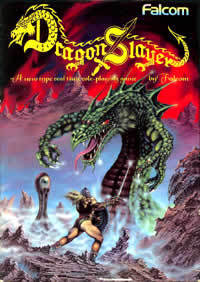Dragon_Slayer_(video_game)
Dragon Slayer (video game)
1984 video game
Dragon Slayer (ドラゴンスレイヤー, Doragon Sureiyā) is an action role-playing game,[2][3] developed by Nihon Falcom and designed by Yoshio Kiya.[4] It was originally released in 1984 for the PC-8801, PC-9801, X1[1] and FM-7,[5] and became a major success in Japan.[6] It was followed by an MSX port published by Square in 1985 (making it one of the first titles to be published by Square),[7] a Super Cassette Vision by Epoch in 1986 and a Game Boy port by the same company in 1990 under the name Dragon Slayer I (ドラゴンスレイヤーI, Doragon Sureiyā Wan). A version for PC-6001mkII was in development but was never released.[8] A remake of Dragon Slayer is included in the Falcom Classics collection for the Sega Saturn.[9]
This article needs additional citations for verification. (December 2009) |
Dragon Slayer began the Dragon Slayer series, a banner which encompasses a number of popular Falcom titles, such as Dragon Slayer II: Xanadu, Sorcerian, and Legacy of the Wizard. It also includes Dragon Slayer: The Legend of Heroes, which would later spawn over a dozen entries across multiple subseries.
